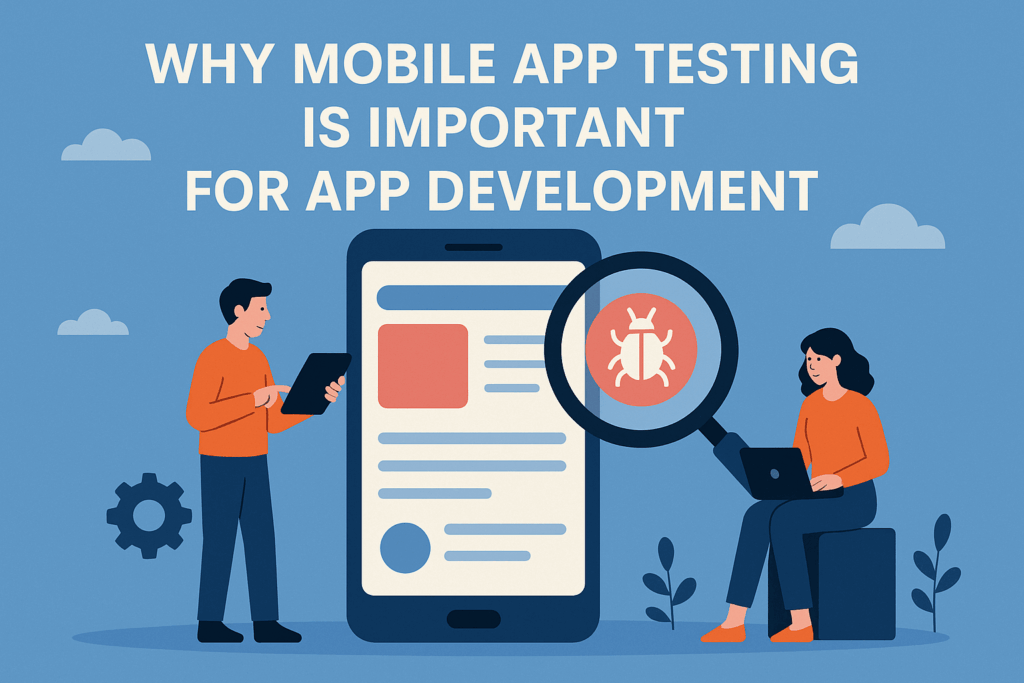The mobile app market has become one of the most competitive digital arenas in the world. Every day, thousands of new apps are launched across iOS and Android platforms. They promise entertainment, productivity, communication, or innovation, but only a fraction of them achieve long-term success. Many apps are uninstalled within minutes of download because they fail to meet basic user expectations for usability, performance, and security.
This reality highlights an often-underestimated step in the development cycle: testing. While developers may focus on features, design, or speed to market, the process of thoroughly validating an app’s quality is what separates winners from failures. Mobile app testing ensures that apps don’t just function as intended but deliver seamless, enjoyable experiences that keep users engaged. Without it, even the most brilliant ideas can collapse under the weight of bugs, crashes, or poor user flows.

Contents
The Role of Testing in App Development
Testing is not a postscript to development, it is a continuous part of the cycle. From the early stages of prototyping to pre-launch validation, testing provides the feedback loop developers need to refine their work. In app development, where timelines are often tight and competition is fierce, some teams are tempted to skip thorough testing to save time. The result is predictable: poor reviews, low retention, and wasted investment.
The role of testing is to ensure that every element of an app aligns with user expectations. It validates whether features behave as designed, whether performance is consistent across devices, and whether the user experience remains intuitive under different scenarios. Testing doesn’t just protect against failure; it actively improves design and functionality, laying the foundation for long-term success.
Ensuring Quality Across Devices and Platforms
One of the defining challenges of mobile app development is the diversity of devices and operating systems. Unlike desktop environments, where hardware and OS variations are limited, mobile ecosystems are fragmented. Android alone runs on thousands of different devices with varying screen sizes, processors, and operating system versions.
Mobile app testing ensures that an app behaves consistently across this wide landscape. Without testing, developers risk releasing apps that work flawlessly on one device but break on another. For users, this inconsistency is unacceptable. They expect apps to load quickly, display correctly, and function without error no matter what device they own. By addressing these challenges during testing, developers prevent negative experiences that could cost them valuable users.
Improving User Experience
At its core, the success of a mobile app depends on user experience. Users are quick to abandon apps that confuse them, frustrate them, or demand too much effort. The app stores are filled with alternatives, and switching costs are low. Testing helps developers identify where users struggle, whether it’s in navigation, onboarding, or completing key tasks.
By catching these pain points before launch, teams can make critical adjustments that improve usability. This might include simplifying menu structures, adjusting button placement, or optimizing performance during peak loads. When testing is integrated into the development cycle, the result is not just a functional app, but one that feels effortless to use. That ease of interaction is what transforms downloads into daily use.
The Cost of Skipping Mobile App Testing
Some teams view testing as an optional expense, especially startups with limited budgets. However, the cost of skipping testing is often far greater than the savings. Poorly tested apps are more likely to crash, receive negative reviews, and face high uninstall rates. In the competitive app market, where visibility and reputation are crucial, these setbacks can be fatal.
Recovering from a bad launch is notoriously difficult. Once users associate an app with frustration, they are unlikely to return, even after fixes are made. Additionally, developers may face increased maintenance costs, as issues that could have been caught early now require extensive patches. In extreme cases, apps may even face security vulnerabilities that damage both user trust and brand reputation. Testing prevents these scenarios, ensuring that issues are addressed proactively rather than reactively.
Enhancing Performance and Reliability
Performance is a cornerstone of mobile app success. Even if features are innovative, users will abandon apps that are slow to load, drain battery life, or consume excessive data. Mobile app testing helps developers identify performance bottlenecks and optimize efficiency.
Testing can reveal whether background processes are consuming too many resources, whether animations cause lag on lower-end devices, or whether servers can handle peak traffic loads. By addressing these issues before launch, developers create apps that feel smooth, reliable, and enjoyable to use. Reliability builds trust, and trust leads to retention, two factors that drive long-term success in the app marketplace.
Security as a Priority
With increasing reliance on mobile apps for banking, shopping, healthcare, and communication, security has never been more important. Users trust apps with their personal information, financial data, and in some cases, sensitive communications. Any breach of that trust can have catastrophic consequences.
Mobile app testing includes validating the security of data storage, transmission, and user authentication. Testing helps uncover vulnerabilities such as weak encryption, insecure APIs, or improper data handling. Addressing these issues before release protects users from harm and shields developers from legal or reputational fallout. In an age where privacy is paramount, robust security testing is not optional, it is a responsibility.
Supporting Agile Development
Many development teams today use agile methodologies, releasing updates iteratively and frequently. In this environment, testing becomes even more crucial. Each update introduces the possibility of new bugs or regressions that affect existing features. Without continuous testing, teams risk breaking functionality while trying to improve it.
Testing supports agile development by providing quick feedback cycles. Automated tests, in particular, allow teams to validate new changes quickly without delaying release schedules. This balance between speed and quality ensures that apps remain competitive in fast-moving markets while still delivering reliable experiences.
The Role of Automation in Mobile App Testing
As apps grow in complexity, manual testing alone is not sufficient. While manual testing is invaluable for exploring user experience, automation provides scalability. Automated tests can quickly validate core functionality across multiple devices and operating systems, ensuring consistency at speed.
By combining manual and automated approaches, developers achieve a more comprehensive testing strategy. Manual tests capture nuanced user behaviors and experiences, while automation ensures that routine checks are performed thoroughly and efficiently. Together, they form the backbone of modern mobile app testing practices.
Boosting App Store Ratings and Reviews
App store visibility is critical to success, and ratings and reviews play a major role in driving downloads. Apps that consistently crash or frustrate users often receive poor reviews, which in turn discourage new users from downloading them. Testing directly influences this cycle by ensuring apps meet expectations before they reach the market.
By delivering apps that function smoothly and reliably, developers improve their chances of earning positive reviews and higher ratings. These ratings enhance visibility in app stores, creating a virtuous cycle where quality leads to discoverability, which leads to more users and greater success.
Meeting Business Goals Through Testing
Mobile app testing is not just about satisfying users, it’s also about meeting business objectives. Whether the goal is to drive sales, increase engagement, or expand brand presence, testing ensures that apps serve their intended purpose. For example, an e-commerce app may prioritize testing its checkout process, while a fitness app may focus on data tracking accuracy.
By aligning testing efforts with business goals, developers ensure that technical performance translates into measurable impact. This alignment makes testing an investment in growth, not just a safeguard against failure.
Future Trends in Mobile App Testing
As technology evolves, so too does the landscape of testing. New trends are shaping how developers validate their apps:
- AI-driven testing: Artificial intelligence can identify patterns, predict user behavior, and automate complex test scenarios.
- IoT integration: With more devices connecting to mobile apps, testing must expand to ensure interoperability.
- 5G performance testing: As 5G adoption grows, apps must be tested for new expectations of speed and responsiveness.
These trends highlight that mobile app testing is not static. It continues to adapt to the changing demands of users, devices, and networks, ensuring apps remain relevant and competitive.
Why it Matters
The journey from idea to app store is filled with challenges, but testing is the one step that ensures success. Mobile app testing validates functionality, safeguards security, enhances user experience, and drives performance across devices and platforms. Without it, even the most innovative apps risk failure in a crowded marketplace.
For developers and businesses alike, testing is not an expense to be minimized but an investment to be maximized. It protects users, strengthens brands, and fuels long-term growth. In the competitive world of app development, where every detail matters, testing is the difference between an app that is downloaded once and forgotten, and one that becomes a daily habit.



